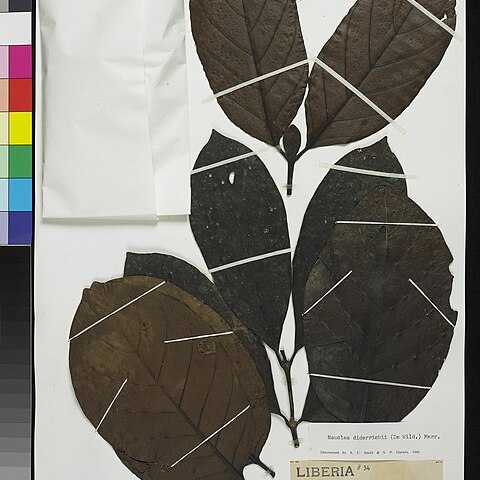Tall rather slender forest tree (9–)30–40 m. tall, with bole attaining 0.9–1.5 m. in diameter, with low or without buttresses; branchlets glabrous; bark light brown, greyish or yellowish, shallowly and longitudinally fissured; slash fibrous, white, turning pale brown.. Leaf-blades broadly elliptic, (4–)7–18(–40) cm. long, (2.5–)4–12(–18) cm. wide (even up to 45 × 21 cm. on sterile shoots), obtuse or very slightly acuminate at the apex, rounded or shortly cuneate at the base, glabrous; petiole 0.8–1.3(–1.8) cm. long; stipules large; foliaceous, oblong-elliptic, 1–2.5(–7) cm. long, 0.4–1.2(–6.8) cm. wide, with a very distinct narrow keel, glabrous.. Inflorescences terminal, 3 cm. in diameter; peduncle short, 1.1–2 cm. long.. Calyx-lobes prismatic or clavate, very short, 1.8–2 mm. long, the lobes unequally joined amongst themselves, thickened and hairy at the tips.. Corolla white, greenish white or yellowish, (4–)6–8 mm. long, the tube narrowly funnel-shaped; lobes 3–4, oblong-elliptic, 1.5–2.7 mm. long, 0.75–1.2 mm. wide.. Style 1.1–1.3 cm. long, exserted 4.5–6 mm. from the corolla; stigma 2 mm. long, acuminate.. Syncarps globose, greyish brown, with whitish flesh, 3–4 cm. in diameter, subechinate and ornamented with a disconnected network of unequallyjoined calyx-lobes surrounding the floral pits.. Seeds brown, ovoid, 1 mm. long, not margined, reticulate.. Fig. 61.
More
A large tree. It grows 40 m high. The trunk is 1.5 m across. It has low buttresses. The bark is grey and furrowed. The leaves are narrowly oval and 40 cm long. The flowers are white and green and in round heads. They are 3 cm across. The fruit is 4 cm across and round and succulent. It is white or grey and has ribs.
Occurs in lowland evergreen forest, at elevations up to 800 metres. A sun-loving species, it regenerates abundantly in gaps and openings and is often almost gregarious in the transition zone between freshwater swamp and lowland forest.
More
A tropical plant. It is native to tropical Africa. It grows in damp sites in rain-forest below 500 m altitude in West Africa. It is best in sunny locations.
To collect seeds, the fruit are dried and then pounded. Dry seed can be stored for at least a year. Seeds are small and so should be put in a nursery and then transplanted. Plants can be grown by cuttings.


